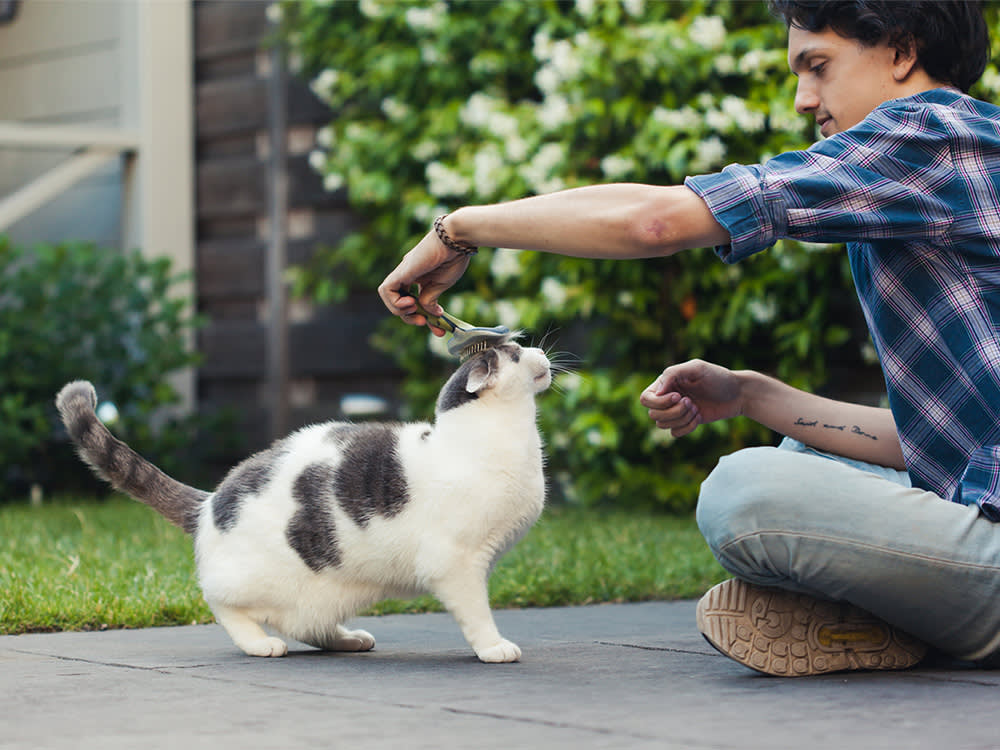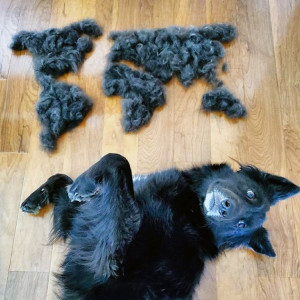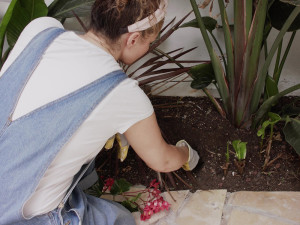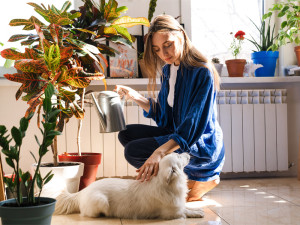7 Ways You Can Upcycle the Tumbleweeds of Pet Hair Floating Around Your House
Turns out, it’s not an annoyance— it’s an opportunity to get creative.
Managing pet fur is a full-time job. There are ways of mitigating the dust-bunnies, allergies, and aesthetic disruption that shedding causes, but we don’t always give much thought to the fur after we brush it off our pets. It turns out tossing it into the trashcan isn’t the only — or best — option.
Here’s what you can do with all those remaining fur-tumbleweeds (other than letting them blow through your house like it’s a Kansas prairie).
Deter pests.
If you’ve been looking for a natural, animal-friendly way to dissuade pests from infiltrating your garden, you’re in luck: Dog hair works as a natural deterrent against critters, such as gophers, squirrels, rabbits, and chipmunks. The animals will smell your dog, think there’s trouble nearby, and leap over your neighbor’s fence.
Just collect some fur, place it around the base of any plants that need protection, and viola: Your veggies are in full bloom and free of tiny bite marks. You can also stuff the hair into burlap bags and tie them up around the yard. Keep in mind that you may need to refresh the supply every once in a while to keep the puppy scent strong.
How much do you spend on your pet per year?
Donate it.
For those of you who aren’t into the idea of reusing pet hair yourself — or just aren’t the DIY crafting or gardening type — you can let Matter of Trust take care of it. It turns out that pet hair is incredibly effective at soaking up oil; it works even better than many synthetic commercial products. When bunched together by a needle-punch machine to make a mat, fur can draw oil out of the water in areas that are polluted by spills or stormwater pollution.
Matter of Trust is putting this science into action. The organization accepts donations of hair, fur, wool, and fleece from anywhere in the world. Just sign upopens in new tab, pack up the fur, and send it to the address you’ll receive via email. Plus, it’s a great excuse to post your pet on your grid (again); the organization encourages you to spread the good word on social media by showing off your pet with their environment-saving fur pile.
Spin yarn.
As it turns out, you can make yarnopens in new tab out of your pet’s brushed hair — in fact, dog hair was the main fiber spun in the Americas before sheep were introduced. If you don’t have the time or desire to spin it yourself, there are a few companies opens in new tab that will make custom yarn out of your pet’s hair.
Stuff toys or pillows.
Have some tattered, de-stuffed toys lying around? Always wanted to try a hand at making a pet toy design of your own? Pet fur can be a great filling. Take the hair, scrub it out with dog shampoo to be sure it’s nice and clean (and scentless!), and then sew it into whatever you’d like: homemade dog toys, pillows, dog beds, or anything else to which you want to add a little softness. It’s a lot more eco-friendly than ordering new products or synthetic filling.
Make felt.
Making felt out of pet hair — or any fiber — is super easy. All you need are two containers, dish soap, and, of course, a bunch of fur. Fill a container with warm water and some dish soap and fill another with cold water. Then simply bunch some fur into a ball, dip the ball into the soapy water, squeeze out the excess water, and rub the fur between your fingers (or into a ball between your palms, if you prefer a round shape). Once it’s felted, dip it into the cold water to rinse. When you’re done, you can use essential oils to add scent to the felt or Kool-Aid to dye it.
Compost.
Good news: Pet hair is compostable and full of plant-nourishing nitrogen, so it can be useful as fertilizer. Be sure to spread the hair out thinly, because it takes longer to break down when it’s in clumps. As long as you aerate your compost by turning it a few times a week, the fur should be broken down in about a month.
Give it to birds.
Birds love to use hair for nests for the same no-brainer reasons we love to cuddle with our pets: It’s delightfully cozy. You can help a busy bird by leaving a mesh bag of pet hair somewhere accessible — maybe even up in a tree — or wrapping tufts around fence posts and branches.
Just be sure that the hair you’re giving hasn’t been treated with flea and tick medication, which could make the fur toxic to birds. Also, keep the length of the hairs short, because long pet fur that gets wet in the rain can become hard and entangling. But don’t wash the hair — that mammal smell can help deter parasites and predators from invading bird nests.










